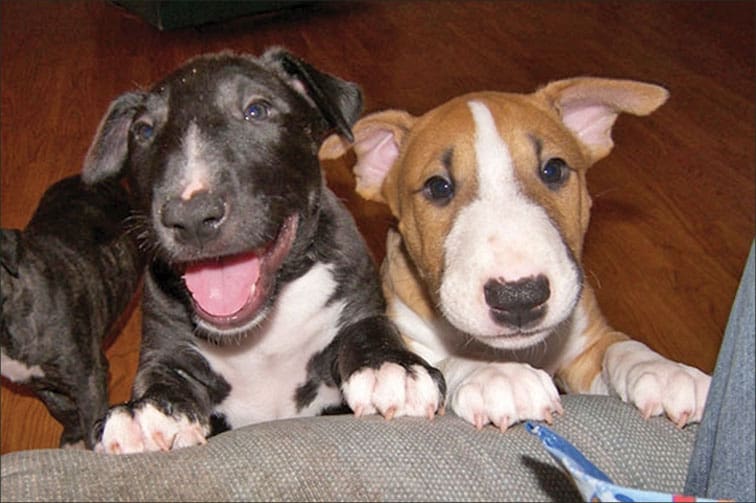[Updated September 6, 2018]
You are a conscientious and skeptical consumer. Whenever you have a choice, you buy quality products that are made to last, by manufacturers who take good care of their workers and the environment, who are mindful of safety, who stand behind their products, and generally follow the best practices to produce them sustainably and ethically. You also know that there are costs to being conscientious. You will pay more up-front, sometimes a lot more. You are willing to wait a long time to get just the product you want. And you hone your radar for advertising claims that mean nothing (cholesterol-free apples?) and scrutinize various allegedly independent seals of approval that serve as marketing smokescreens for sellers who want to exploit your conscientiousness.

Here’s a challenge, though: Can you apply that smart, honed, skeptical consumer consciousness to the next dog or puppy that you buy or adopt? Can you resist the first adorable puppy that is plopped into your arms, or the desperate sad story on a Petfinder entry?
Not only can it be done, it must be done, if you are deeply involved with your own dogs and care a great deal about the welfare and future of dogs in general. This is the acquisition that most demands a restrained, educated, skeptical approach that serves your own self-interest as well as supporting practices that are good for dogs. For no other purchase does intelligent self-interest mesh so closely with good social ethics, whether you are buying a purpose-bred puppy or selecting the best-for-you “used” dog from a shelter or rescue.
Here’s how to identify an ethical breeder – one whose concern for the welfare of her dogs and devotion to the future of her breed extends to the well-being of those dogs’ owners. Next month, we’ll describe how to identify legitimate, top-quality rescues, and avoid those that apply more sentiment than expertise, as well as frank swindlers who prey on animals and kind hearted people.
How to Find Ethical Dog Breeders
It can be difficult to give useful generic advice about many aspects of buying a purpose-bred puppy. The husbandry practices, selection criteria, and to some extent the attitudes that make a great Bichon breeder would be anathema to someone breeding Belgian Malinois. Different breeds have different cultures. I can’t tell you the fair price for a puppy – what is highway robbery and what is alarmingly cheap. I don’t know what health conditions beset the breed of your choice. I don’t know whether the breed club offers transparent guidance or is purely a marketing smokescreen. (I can tell you with reasonable certainty that the search terms “puppies for sale” or “puppies” will bring you almost exclusively the new marketing-savvy Internet-based puppymillers, who now know how to work search engine optimization.) I don’t know which Yahoo list or Facebook group offers the best discussion and the most honest direction. You are going to have to find out the specifics for the kind of dog you seek; I recommend that you find guides and mentors who know the breed well and have nothing to sell you.
That said, some field marks of the ethical breeder are general in nature. Her opposite number is the puppymilling profiteer. Both self-interest and social responsibility depend on you avoiding that puppymiller.
Here are some feathers and crests to look for as you winnow through the information overload:
THE BREEDER DOES SOMETHING WITH HER DOGS.
I mean, other than make puppies with them. She’s part of a community of dog-lovers, hobbyists, and professionals who compete or perform service with their own dogs. Their dogs are seen and assessed by other experts, and there are thresholds – a working title or certificate, a conformation championship, breed-survey rating, temperament tests, qualifying in a trial – that dogs achieve before being bred.
Veteran French Bulldog breeder and rescuer Carol Gravestock and I come from radically different tribes of the dog nation (that’s why I asked her for input). For the two working breeds that I own, a conformation (show ring) championship is a clear signal to avoid the dog’s progeny and the breeder, because of health, temperament, and breed conservation considerations. In Carol’s world, with a breed designed from the outset purely as house pets, “You have to show. It’s how you earn the right to breed a litter.”
As you scrutinize the performance claims about the breeder’s sires and dams, though, beware of “champion lines.” How many of those champions – or obedience-titled dogs, police canines, hunt-tested retrievers, etc. – are or were owned by the seller? Do the pup’s parents number among them? Alas, it is not difficult to buy the grandson of champions to spruce up the ol’ pedigree charts on the website. Your questions about a pup’s ancestry should be guided by the principle, “What have you done for me lately?”
THE BREEDER HAS AS MANY, OR MORE, QUESTIONS FOR YOU THAN YOU DO FOR HER.
She’s nosy. All up in your underwear drawer. Seems judgmental. Probably has an application that you must fill out, sometimes before she will talk to you or correspond at any length. You feel a bit violated. Like you have to prove to her that you are worthy of one of her pups. Because you do.

(Please refrain from snorting, “This is worse than adopting a child!” People who have adopted a human child, or who have tried to adopt and been unable to do so, don’t find it a bit funny.)
In contrast, says Gravestock, “With puppymills, the dogs are their job, and they work that job. That means answering the phone and returning emails in 30 seconds flat, and being charming. They have a product to sell; their product is a puppy, and they are salesmen.
“Ethical breeders work to support their dogs; their dogs do not support them,” says Gravestock. They may not get back to you the day you call, and they will not be charming and aggressive in their eagerness to sell you a puppy, because that breeder’s number one goal is to ensure that every puppy goes to a lifetime excellent home, not getting every puppy paid for and out the door the moment he is weaned.
“Good breeders are paranoid – we are downright afraid of you, puppy buyers of the universe! Those of us who do rescue have seen the worst-case scenarios.”
The benefit to you of cultivating a relationship with someone this cautious? A breeder who is very careful about where her puppies go is the same breeder who is there for the life of the dog, to answer your questions, help you with any problems, cheer you on in your endeavors, and take away the worry of what would happen if you could no longer keep your dog. Every one of her puppy-buyers is a dog-in-law.
A GOOD BREEDER CHECKS REFERENCES.
You provide personal and veterinary references, and she calls those people and grills them about you, your character, your experience as an animal owner, and even your personality. She may also insist on visiting your home, or sending someone she designates who is near you.
Note that puppymills are increasingly sophisticated about mimicking the appearance of good breeders. Many now have applications on their “click & buy” websites, and some of those applications ask for references. But they will not actually call the references you provide. When you provide references to a breeder, let those people know you have done so (that’s just polite), and ask them to call you after they speak to the breeder so you can find out what the conversation was about. I’ve found conversations with personal references to be extremely valuable in matching pups to new families.
THE BREEDER IS ALSO VERY HAPPY TO PROVIDE REFERENCES.
Call and question the breeder’s references! For example: “Would you buy another puppy from this breeder? Why?”
I always advise puppy-buyers, and dog owners looking for a trainer, to ask for references. In 20 years of professional training and nine years of breeding, I have never had anyone ask me for a reference. Not one person.
THE BREEDER USES A SALES CONTRACT THAT PROTECTS THE PUPPY’S WELFARE, THE BREED’S WELFARE, YOUR INTERESTS, AND HER INTERESTS – IN ABOUT THAT ORDER.
Review the contract. What does the “health guarantee” cover? Puppymillers have discovered that written contracts not only make them look legit, they can be used to weasel out of obligations that would otherwise be presumptive under law. Carol Gravestock cautions buyers to look for the “dead dog clause” in any health guarantee. If the breeder requires you to return the puppy to her in order to receive anything back, she is using the “health guarantee” to guarantee that you will not invoke the contract and she can keep your money. Who would send back his beloved ill pet to a breeder who will have the dog put down, and then accept another puppy from the same person as “replacement?” Not you, right? The profiteering puppymiller is counting on that.
Also, if you live in Florida and have the pup shipped from Missouri, you won’t be able to return the pup with parvo to the seller because no vet will sign a travel health certificate for him. Catch-22.
Good breeder contracts are well-meaning, if (unfortunately) not always well-written. (If you are a lawyer, paralegal, or just good with contracts, do your new dog-in-law a kindness and offer to help her with her puppy contract. There is a 98% probability that hers is vague, unenforceable, and generally terrible, concealing rather than advancing her best intentions. In contract law, the thought does not count.)
Talk with the breeder about the terms of the contract, and what is guaranteed by the breeder, as well as the obligations you take on. The best breeders will want you to agree to provide good husbandry to the pup, to accept limits on the circumstances under which the pup might be bred, to perform specific health tests, and share the health test results when the pup is of the appropriate age. And every ethical breeder obliges herself to take back your puppy if you ever cannot keep him, often requiring that you give her the right of first refusal before the dog ever changes hands.

If the contract does not include an RTB – a “return to breeder” clause – walk away. It is your dog’s ultimate safety net, and the surest field mark of a breeder who puts dogs before her own profit and convenience. If every dog breeder enforced an RTB, there would be no Part II of this article (regarding ethical rescue groups and shelters).
THE BREEDER SPEAKS MORE ABOUT HER ADULT DOGS, THEIR ACCOMPLISHMENTS, BACKGROUNDS, QUALITIES, AND SHORTCOMINGS, THAN ABOUT ANY PUPPIES FOR SALE, PRESENT OR FUTURE.
Your poor brain will throb as the breeder spins out a story of ancestors and relatives in a pedigree that you cannot hope to parse; this is a sign that the breeder is more concerned with the character of her dogs than with the perishable marketability of a puppy.
In contrast, a puppymill’s website will almost invariably consist of pages of individual mugshot photos of each freshly bathed, shell-shocked pup, showing color and markings, with a draped background or sofa cushions, and often with adorable props. There may be a payment button next to each photo. Adult dogs, if present at all, are relegated to the background of the marketing efforts. (Betsy and Ranger had eight darling puppies, ready for adoption just in time for Christmas!) When you speak to this breeder, she will have a lot to say about the pups that she currently has for sale, but little that is insightful about their parents, older siblings, ancestors, uncles, and aunts.
GOOD BREEDERS PERFORM THE APPROPRIATE HEALTH TESTS FOR THE BREED, SHARE THE RESULTS OPENLY, PROVIDE DOCUMENTATION OF THOSE RESULTS, AND CAN JUSTIFY THEIR DECISIONS TO BREED EACH INDIVIDUAL DOG.
Don’t fall for claims that the pups are “health tested” and “DNA verified.” So? What health tests? Some puppymillers market pups as “health tested” because they have the federally required health certificate for shipping before they board the airplane! (We have now entered the realm of certified low-sodium broccoli.) And yes, all animals have DNA; I can verify that for you right now.
And what of the results? A breeder who has her dogs’ hips radiographed and rated by OFA or PennHIP, and then breeds each dog regardless of the results of the test, is not performing due diligence. (The good hip scores become marketing fodder, while the bad ones are buried in silence and denial.)
The appropriate health tests vary widely by breed; this is why you must research the breed or type of dog thoroughly before contacting breeders. A Saluki breeder who doesn’t check hips is normal, because Salukis do not have an issue with poor hips in their gene pool; it would be an expensive diagnostic test performed for no purpose. But a Labrador breeder who skips this test “because my dogs have never had a problem,” or who spins a tale about how it’s all feeding them right and keeping them off slippery floors, is selling snake oil. If a breeder doesn’t health test, doesn’t share the results, won’t give you documentation unless you buy a puppy or put down a deposit, or is any way cagey, walk away.
Most health tests do not guarantee that your pup will be unaffected by the problem that the test evaluates. Only a few tests for simple genetic mutations can determine that. However, good test results increase your odds of getting a pup who is free of that issue – and you support someone who follows best practices.
Once you have the results of the parents’ health data (and, ideally, grandparents, uncles and aunts, and any older siblings if applicable), you should ask someone who is an expert in the breed and has nothing to sell you to explain them, ideally without letting on who the dogs or breeder are. This is likely not your veterinarian – unless she owns that breed and has an interest in breeding and genetics. Another breeder, or a trainer, dog sports competitor, or other professional who has a lot of experience with the breed, is often your best source for disinterested information.
And no matter how many Good Housekeeping Seals a pup’s parents can present, you still need to inquire pointedly about overall health in his family. Who cares if the parents have fantastic hips, eyes, elbows, knees, and cardiac function if all four grandparents died of cancer by age six, Dad has epilepsy, and Mom has a running bar tab at the vet?
THE BREEDER BREEDS ONE BREED OF DOGS. MAYBE TWO. PROBABLY JUST ONE.
It takes years to become an expert in just one breed of dog; a breeder may own one or two dogs of other breeds, but she’s a specialist in just one.
Puppymillers know that buyers will encounter this advice, so they now separate the websites of their different breeds. Google is your friend; check phone numbers, business names, individual names, and any other keywords you can glean for signs that the breeder has multiple websites for different breeds of dog. Hiding these parallel websites is a sign that there is something to hide.
THE BREEDER BREEDS ONLY MATURE DOGS, AND EACH FEMALE IS BRED INFREQUENTLY. (CERTAINLY NO MORE THAN ONCE A YEAR.)
No puppies having puppies. That means, at minimum, that each dog is two years old before being bred. Older is better, especially in slow-maturing breeds. Males, in particular, may be quite mature before siring puppies. If your pup’s parents are mature, ask about their reproductive history. If Momma, or any other bitch the breeder owns, is on her fourth litter at age five, you have your answer. If the breeder is cagey about answering, walk away.
THE BREEDER HAS LITTERS INFREQUENTLY, ONE AT A TIME. YOU ARE LIKELY TO HAVE TO WAIT, POSSIBLY A CONSIDERABLE TIME, FOR A PUP TO BE AVAILABLE TO YOU.
Puppies take a lot of care, and it’s not just constant feeding and cleaning. A good breeder spends hours every day observing and interacting with the pups to learn as much as possible about each one and to socialize them thoroughly. They have puppy socialization parties with friends, take the tykes on field trips, and lose countless hours to puppy reverie.

Even a house full of highly disciplined home-schooled children can’t properly socialize, much less assess, 20 or 30 pups at a time. And there is no way that a breeder can effectively screen potential homes with diligence with so many pups at once. Ethical breeders all report being drained and exhausted after raising a litter, mostly due to the hours spent screening potential buyers and agonizing over puppy matches. Puppymillers like to produce in big batches for efficiency.
Occasionally a breeder plans two litters in a year for compelling reasons, and her bitches synchronize so that the only way to manage it is to have them close together. But the breeder should present this as an exception without prompting. Most who try it once swear “never again” while lying in a dark room with a cold compress on their foreheads.
YOU ARE ENCOURAGED, IN SOME CASES REQUIRED, TO VISIT THE BREEDER’S HOME TO PICK UP YOUR PUPPY.
(This is always where the puppies and their mother live, by the way.) Preferably, you visit before picking up the puppy – perhaps even before pups are born or conceived. This can vary depending on how common the breed is and how far you have to go, but you are always welcome to visit with polite notice at a mutually convenient time.
If the breeder offers to meet you somewhere off-site “to save you driving time” or to deliver the puppy to you, proceed with great caution. Sometimes these offers are sincere; say, the breeder is traveling for a dog show to your area anyway. Tell her that you’d rather come to her and meet the pup’s mother and other relatives. If she is resistant, walk away.
If you get as far as visiting the breeder’s home and the pups or adult dogs are dirty, crowded, stinky, isolated, caged, scary, fearful or in any way not what you would wish for every puppy, everywhere, walk away.
If you can’t meet the adult dogs, walk away.
If you would not wish to own the puppies’ dam, walk away.
THE CHANCE THAT A BREEDER WHO IS USDA-LICENSED IS NOT A PUPPYMILLER IS ESSENTIALLY NIL.
Ethical breeders do not produce enough puppies to require this licensure.
IF THERE IS ANY INDICATION THAT THE SALE OF PUPPIES IS PAYING THE MORTGAGE, THAT THE DOGS ARE SUPPORTING THE BREEDER, WALK AWAY.
You can be sure that the dogs’ dependent is making compromises about the dogs’ welfare: whether to breed that bitch who had a litter six months ago, what brand of dog food to buy, does this pup really need to see a vet? And if you find that you must return your puppy a year or 10 after bringing him home, you will also find that that charming aw shucks farm lady who just loved all her li’l puppies to death when they were ripe and shiny and for sale is not returning your calls; if you catch her, you can expect, at best, a referral to a breed rescue.
An ethical breeder, a great breeder, doesn’t just take her own puppies back at any age, for any reason, she supports breed rescue and other animal welfare causes. She may pull, evaluate, transport, and foster dogs that puppymillers forgot about the minute the check cleared. She might sit on the board, fundraise, or just cut a check at Christmas. She helps salvage the mess created by those “other” breeders.
Consider Adoption Instead
Speaking of rescue, those who prefer a quality recycled companion can learn how to them among the official nonprofits. Here are some helpful links to get you started:
Finding the Best Animal Shelters
Successful Dog Adoption, Part 1: Develop an Adoption Criteria
Successful Dog Adoption, Part 2: What To Do at the Shelter






Nice article. The only point of contention I have is with your blanket statement that dams are never bred more than once a year. This is not a valid metric as science now shows that it is better to breed ‘back to back’ (ie consecutive cycles) from a health perspective. Some ethical breeders breed back to back to back until done. Others will breed back to back – skip – then breed again. For me it is dependent primarily on the health of the dam. We know that what is best for most is to breed until done then stop and spay but individual determinations have to be made both in terms of whether the dam is ready for another litter…and whether I as a breeder have the ability to put everything I need to in a litter right then. I would say that it is more about the big picture and not one arbitrary point like breeding once a year, or only breeding x litters. Each dog is different in terms of health, mothering etc.
Love the emphasis on health-testing. Several inaccuracies: breeding back to back is recommended for reproductive health and a lot of breeders do exactly what you identify as a red flag: breed two litters, skip a heat, breed two litters and then retire the bitch from breeding by the age of 5 or 6. There are breeders who seriously breed more than one breed. Simply, they should be able to provide the same proof of their dedication and success in each breed. Personally my journey with each breed has helped make me overall a better breeder. Finally there are a LOT of serious, responsible breeders who have to be USDA inspected because they have more than 4 females or they want to be able ship their puppies.